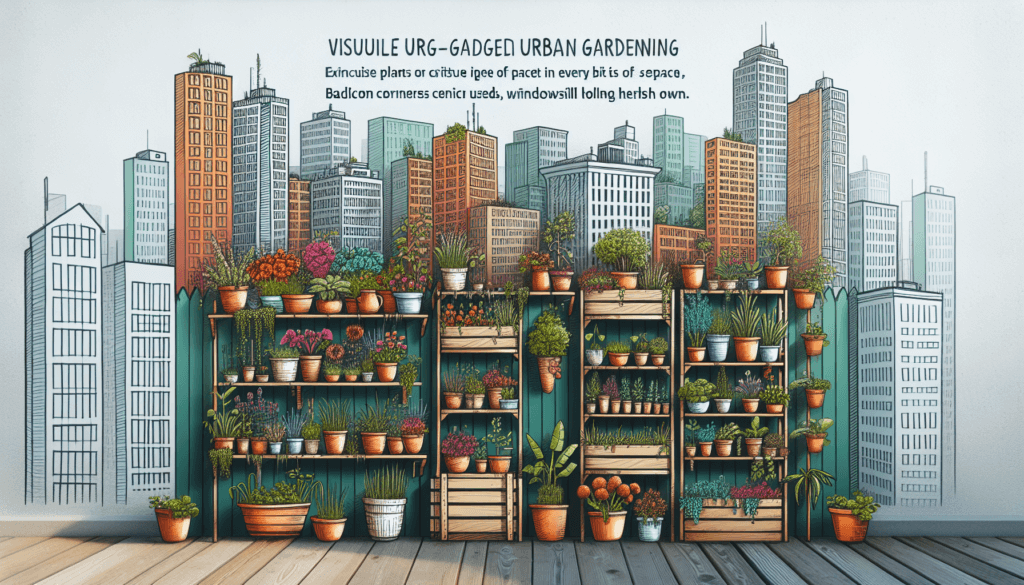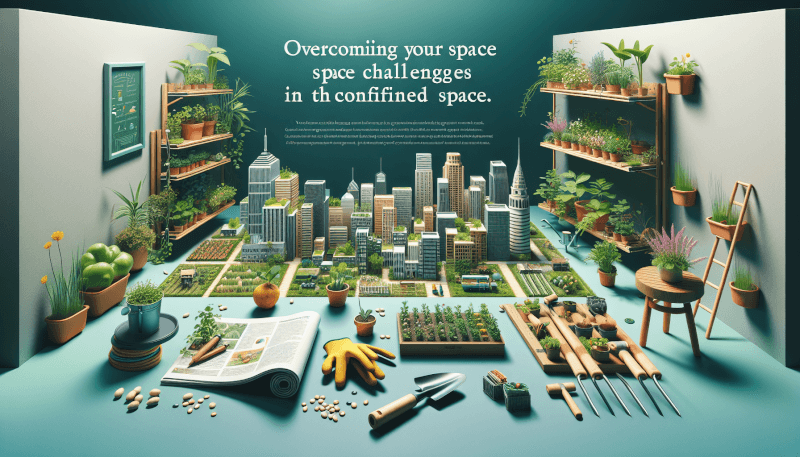Have you ever wanted to grow your own fresh vegetables and herbs, but felt limited by your small living space? Well, the good news is that no matter how little room you have, it’s still possible to start your very own urban garden! In this article, we’ll share some practical tips and tricks on how to maximize your space and create a thriving garden right in the heart of the city. So get ready to roll up your sleeves, because we’re about to show you how to transform your small space into a green oasis of your dreams!

Choosing the Right Location
When starting an urban garden in a small space, choosing the right location is crucial for the success of your plants. Assessing sunlight is important to ensure that your plants receive enough light to grow and thrive. Look for a spot that receives at least six hours of direct sunlight each day. Consider the orientation of your urban garden and how shade from nearby buildings or structures may affect sunlight exposure.
In addition to sunlight, considering wind exposure is also important. Strong winds can damage plants and affect their growth. Choose a location that is sheltered from strong winds, such as against a wall or near a fence. This will help protect your plants and create a more favorable growing environment.
Identifying the available space is another key factor when choosing the right location for your urban garden. Look for areas that are free from obstructions and have enough room to accommodate your desired garden size. Consider both vertical and horizontal space to maximize the potential of your small urban garden.
Lastly, analyzing soil quality is essential to ensure that your plants have a suitable growing medium. Assess the soil’s texture, drainage capability, and nutrient content. If the soil quality is not ideal, you can improve it by adding organic matter or using raised beds or containers with quality potting mix.
Container Selection
Choosing the right containers is crucial when starting an urban garden in a small space. Consider both the size and material of the containers to meet the needs of your plants.
Choosing the right size of containers is important to provide enough space for your plants’ roots to grow. Consider the mature size of your plants and choose containers that allow for adequate root development. Keep in mind that larger containers will require more soil and water, so balance the desired size with practicality for your specific space.
Selecting the right material for your containers is also important for the health of your plants. Consider factors such as durability, insulation, and weight. Common container materials include clay pots, plastic containers, and fabric bags. Each material has its advantages and disadvantages, so choose the one that best suits your needs and preferences.
Considering drainage is essential to prevent waterlogging and root rot. Ensure that your chosen containers have drainage holes at the bottom to allow excess water to drain away. If your containers do not have drainage holes, you can always create them yourself using a drill or hammer and nails.
Exploring vertical gardening techniques can also be beneficial when space is limited. Utilize vertical space by using hanging baskets, trellises, or vertical planters to grow plants vertically. This can help maximize your garden’s potential and create a visually appealing display.

Selecting the Right Plants
When starting an urban garden in a small space, selecting the right plants is crucial for success. Identify the plant requirements and choose plants that are suitable for your specific growing conditions.
Consider the space restrictions of your urban garden and choose plants that can thrive in compact areas. Look for varieties that have a more compact growth habit or can be trained to grow vertically. This will help you make the most of your limited space and ensure that your plants have enough room to grow.
Exploring dwarf varieties of plants can also be beneficial for small urban gardens. Dwarf varieties are bred to be smaller in size but still produce a good yield. Look for compact fruit trees, vegetables, and herbs that are specifically bred to grow well in containers or small spaces.
Opting for compact plants can also help maximize the productivity of your urban garden. Choose plants that have a high yield and require less space to grow. Look for varieties that are bushy or have a compact growth habit, such as cherry tomatoes or compact lettuce varieties.
Preparing the Soil
Preparing the soil is an essential step in starting an urban garden. It is important to create a healthy and nutrient-rich growing medium for your plants to thrive.
Start by removing weeds and debris from the area where you plan to have your urban garden. Weeds can compete with your plants for nutrients, sunlight, and water. Remove any existing vegetation to give your plants a clean start and prevent weed growth.
Improving drainage is crucial, especially in small-space gardens. Ensure that the soil has good drainage by amending it with organic matter such as compost or well-rotted manure. This will help create a loose and well-draining soil structure.
Adding organic matter to the soil is beneficial for its nutrient content and overall health. Organic matter can improve soil fertility, water-holding capacity, and nutrient retention. Mix in compost, worm castings, or other organic fertilizers to provide essential nutrients for your plants.
Testing the soil pH is also recommended to ensure that it is within the appropriate range for your chosen plants. Most plants prefer a slightly acidic to neutral pH, around 6.0 to 7.0. Use a soil testing kit to determine the pH of your soil and make any necessary adjustments with the help of organic amendments or specialized pH adjusters.

Watering and Irrigation
Watering and irrigation are essential aspects of maintaining a healthy urban garden. Determining the watering needs of your plants is important to prevent overwatering or underwatering.
Each plant has different watering requirements, so it is important to research the specific needs of the plants you are growing. Factors such as plant size, growth stage, and environmental conditions will affect how often and how much water they need. Check the soil moisture regularly and water your plants when the top inch of soil feels dry.
Choosing the right irrigation system can help you efficiently water your urban garden. Consider factors such as the size of your garden, water availability, and personal preferences. Common irrigation systems include drip irrigation, sprinklers, and soaker hoses. Choose a system that best suits your needs and allows for uniform watering of your plants.
Implementing drip irrigation can be particularly beneficial for small-space urban gardens. Drip irrigation delivers water directly to the root zone of plants, minimizing water wastage and reducing weed growth. It is a cost-effective and efficient method for watering your plants.
Exploring self-watering containers can also help maintain optimal moisture levels in your urban garden. Self-watering containers have a reservoir that holds water, allowing the plants to draw moisture as needed. This can be especially helpful if you have a busy schedule or if watering your plants manually is challenging.
Fertilizing and Nutrient Management
Proper fertilizing and nutrient management are crucial for the health and productivity of your urban garden. Understand the nutrient requirements of your plants and choose the appropriate fertilization method.
Understanding the nutrient requirements of your plants is essential to provide them with the necessary elements for growth. Most plants require a balance of primary macronutrients (nitrogen, phosphorus, and potassium), secondary macronutrients (calcium, magnesium, and sulfur), and micronutrients (iron, zinc, copper, etc.). Research the specific nutrient needs of your plants and choose a fertilizer that provides a balanced blend of these elements.
Choosing between organic or synthetic fertilizers is a personal choice that depends on your gardening philosophy. Organic fertilizers are derived from natural sources such as compost, bone meal, or seaweed. They release nutrients slowly and improve soil fertility over time. Synthetic fertilizers, on the other hand, are manufactured and provide readily available nutrients for plants. They can be more precise in nutrient delivery but may lack the long-term soil-building benefits of organic fertilizers.
Applying fertilizers properly is important to prevent nutrient imbalances and potential damage to your plants. Follow the recommended application rates and timing indicated on the fertilizer packaging. Avoid over-fertilization, as excess nutrients can lead to nutrient leaching, water pollution, or plant burn. Consider using slow-release fertilizers for container-grown plants, as they provide nutrients gradually over an extended period.
Considering composting can be an excellent way to utilize kitchen scraps, yard trimmings, and other organic materials. Compost is a nutrient-rich organic matter that can be used as a natural fertilizer and soil amendment. It helps improve soil structure, water retention, and microbial activity. Start composting and incorporate homemade compost into your urban garden to enhance soil fertility and reduce waste.

Managing Pests and Diseases
Managing pests and diseases is an important part of maintaining a healthy urban garden. Identifying common urban garden pests and implementing effective pest control strategies is essential.
Identify common urban garden pests such as aphids, caterpillars, slugs, or snails. Regularly inspect your plants for signs of pest activity, such as chewed leaves, holes, or sticky residue. Early detection can help prevent pest populations from getting out of control.
Implement integrated pest management (IPM) strategies to manage pests effectively. This approach combines cultural, biological, and chemical controls to minimize pest damage while minimizing harm to beneficial insects and the environment. Examples of IPM practices include using insecticidal soap, introducing beneficial insects, or practicing companion planting.
Exploring organic pest control options can be a safer and more environmentally friendly approach. Organic pest control methods rely on natural substances such as neem oil, vinegar, or diatomaceous earth to deter pests. These methods are effective in managing common pests and can be used as part of an overall IPM strategy.
Detecting and treating plant diseases is also crucial for the health of your urban garden. Learn to recognize symptoms of common plant diseases such as powdery mildew, blight, or root rot. Practice good sanitation, such as removing infected plant debris, and consider using disease-resistant plant varieties. If necessary, utilize organic or chemical treatments to control and prevent the spread of diseases.
Harvesting and Pruning
Harvesting and pruning your urban garden are essential tasks to ensure plant health and maximize productivity. Proper techniques and timing will help you achieve the best results.
Determining the harvest time for your plants is important to ensure optimal flavor, texture, and nutrient content. Research and identify the correct stage of maturity for each plant you are growing. For vegetables, harvest when they reach the appropriate size and color. For fruits, harvest when they are fully ripe or slightly underripe for better shelf life.
Proper pruning techniques help maintain plant health, control growth, and enhance productivity. Remove dead or diseased plant material regularly to prevent the spread of diseases. Prune for shape and structure, removing excessive growth or crossing branches. Also, consider thinning fruit trees to improve air circulation and promote better fruit quality.
Avoid overharvesting to maintain plant health and productivity. Harvest only what you need and allow the remaining fruits or vegetables to ripen fully. Overharvesting can weaken the plant and reduce its ability to produce more crops. Harvesting in moderation ensures continuous production throughout the growing season.
Maintaining plant health is crucial throughout the growing season. Regularly monitor your plants for signs of stress, nutrient deficiencies, or pests. Address any issues promptly by adjusting watering, fertilizing, or taking appropriate pest control measures. Proper plant care and maintenance will maximize the potential of your urban garden.

Ensuring Adequate Lighting
Ensuring adequate lighting is essential for the growth and development of your urban garden, especially when space is limited. Supplementing natural light or using grow lights can help provide the necessary light intensity for your plants.
Supplementing natural light is important when your urban garden receives limited direct sunlight. Choose areas with the most sunlight exposure and maximize the available light by using reflective surfaces such as mirrors or aluminum foil. Additionally, consider orienting your containers or planters to optimize light penetration.
Using grow lights can be an effective way to provide consistent and supplemental light to your urban garden. LED, fluorescent, or high-intensity discharge (HID) lights are commonly used for indoor gardening. Research the specific light requirements of your plants and choose the appropriate grow lights that emit the right spectrum and intensity of light.
Positioning lights properly is important to ensure uniform light distribution among your plants. Hang or mount lights according to the recommended distance from the plants. Adjust the light height as your plants grow to maintain an appropriate distance and prevent potential light burn. Regularly check and clean the light fixtures to ensure optimal light output.
Monitoring light intensity is essential to prevent light stress or insufficient light exposure for your plants. Use a light meter to measure the intensity of light reaching your plants. Research the specific light requirements of your plants and adjust the lighting duration or intensity accordingly. Maintaining the proper light levels will ensure healthy growth and maximize your urban garden’s potential.
Maximizing Space Efficiency
Maximizing space efficiency is crucial when starting an urban garden in a small area. Utilize various techniques to make the most of your limited space and increase your garden’s productivity.
Utilizing vertical space is an effective way to maximize your urban garden. Use vertical planters, hanging baskets, or trellises to grow trailing or vining plants. Train plants to grow vertically by using stakes or supports. This technique not only saves space but also creates an attractive and lush garden display.
Implementing companion planting can help maximize the productivity of your urban garden. Choose plant combinations that benefit each other, such as planting herbs alongside vegetables to repel pests or attract beneficial insects. Research compatible companion plants and plan your garden layout accordingly to optimize space and create a harmonious plant community.
Creating hanging gardens is another space-saving technique for small urban gardens. Hang pots, baskets, or even shoe organizers on walls, fences, or railings to grow herbs, flowers, or small vegetable plants. This vertical gardening approach adds visual interest and allows you to grow plants where space is limited.
Utilizing window sills is a convenient way to grow plants in small urban spaces. Place pots or trays of herbs, small vegetables, or flowers on windowsills to take advantage of the natural light. This technique is particularly helpful when you have limited outdoor space but still want to enjoy the benefits of gardening.
By following these steps and utilizing effective techniques, you can successfully start and maintain an urban garden in a small space. Remember to assess sunlight and wind exposure, choose the right containers and plants, prepare the soil, properly water and fertilize, manage pests and diseases, harvest and prune, ensure adequate lighting, and maximize space efficiency. With dedication and proper care, your urban garden will flourish and provide you with fresh produce and a delightful green oasis in your small space.

